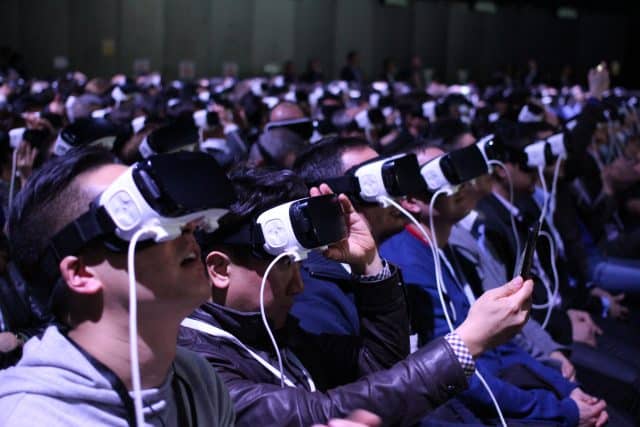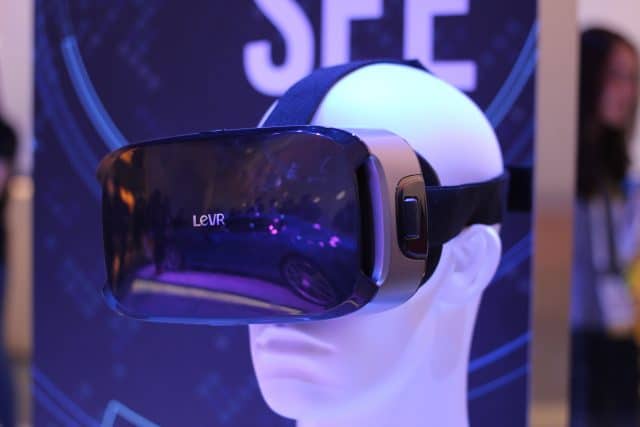Over the past decade there have been a series of significant technological innovations which have revolutionised modern day life; from social media and smart phones to AI personal assistants such as Siri, Alexa and Cortana. The next step in technological innovation seems to Virtual Reality (VR); an industry which is expected to generate approximately $110 billion in revenue within the next decade. This statistic is hardly surprising when you consider that there are estimated to be roughly 171 million active VR users in 2018!
 Samsung’s Virtual Reality MWC 2016 Press Conference
Samsung’s Virtual Reality MWC 2016 Press Conference
What is VR?
In its essence, virtual reality (VR) is the creation of a simulated environment within which users can interact with their surroundings via a headset such as the Oculus Rift, HTC Vive, Playstation VR, Google Daydream View or Samsung’s Gear VR. These headsets completely cover the user’s eyes and create a completely immersive 3D experience as opposed to conventional 3D TV experiences which simply enable users to view a screen in front of you.
Most commonly used for playing computer games, VR headsets can also be utilised for viewing interactive media content such as movies, TV programmes and even adult videos. As such, these VR headsets are generally considered to be recreational devices. However, experts have suggested that VR could become an integral part of our day-to-day lives in the years to come. In fact, many officials have suggested that VR could be the key to happiness! As Palmer Luckey, founder of Oculus Rift, explained within a February 2016 WIRED interview;
“Everyone wants to have a happy life…but it’s going to be impossible to give everyone everything they want…But VR can provide billions of people with virtual versions of everything the wealthy take for granted: touring the Louvre, sailing the sun-dappled coast of California, or simply sitting in a meadow beneath a clear blue sky free of smog and pollution…Virtual reality can make it so anyone, anywhere can have these experiences”.
John Carmack, the chief technology officer at Oculus Rift, reinforced this point and highlighted how the current affordability of VR headsets could make these plans a reality. As Carmack puts it in his own words;
“These are devices that you could imagine almost everyone in the world owning…This means that some fraction of the desirable experiences of the wealthy can be synthesized and replicated for a much broader range of people…If someone wanted nothing more in life than to read books, providing them with a massive library is not doing them a disservice, even if that means that they are less likely to be involved in other activities…If people are having a virtually happy life, they are having a happy life. Period”.
 Razer OSVR Open Source Virtual Reality For Gaming (January 2015)
Razer OSVR Open Source Virtual Reality For Gaming (January 2015)
Future applications of VR technology
Given that many VR headsets are comparable in price to smart phone devices, it is entirely feasible that VR technology could soon become a common feature within most households over the course of the next decade. Especially when you consider that several VR companies have already begun to collaborate with a wealth of different organisations; from educational facilities (approximately one quarter of schools already use VR in some capacity) to social media networks such as Facebook (who bought Oculus for $2 billion in 2014).
Case and point – a Touchstone Research released an article detailing how Facebook have invested $250 million in the creation of more VR content. In December 2016 Oculus launched ‘Rooms’ and ‘Parties’ which enable Facebook users to chat, make calls and socialise in virtual space via their VR headsets. When you consider that 87% of American adults are online and that 74% use social networking sites, there is currently a vast audience of potential VR users who could potentially utilise this technology on a daily basis.
Furthermore, this Touchstone Retail article also revealed the ways in which many retail companies and corporations have begun to adopt VR strategies; with companies hosting VR webinars for clients and potential investors and retail stores such as IKEA launching virtual experiences which enable customers to walk around and interact with IKEA products in one of their virtual kitchens.
Mental health benefits of VR technology
But what impact could this technology have on our happiness levels? Studies have already shown that technological aids such as smart phones can be incredibly addictive. In fact, researchers found that participants suffered from anxiety, elevated heart rates, blood pressure and stress levels when their smart phones were out of reach!
So could the same addictive traits and anxiety be associated with VR technology? Quite the opposite to be exact. Psychologists have even suggested that virtual reality experiences could be used to treat psychological health conditions such as social anxiety, loneliness and support mental relaxation in general. As one March 2017 article in The Guardian proposed;
“The answer lies in VR’s extraordinary ability to create powerful simulations of the scenarios in which psychological difficulties occur. Suddenly there’s no need for a therapist to accompany a client on a trip to a crowded shopping centre, for example, or up a tall building. Situations that are more or less impossible to build into a course of therapy — flying, for example, or the shocking events that often lie behind PTSD — can be conjured at the click of a mouse. The in-situ coaching that’s so effective for so many disorders can now be delivered in the consulting room, with the simulations graded in difficulty and repeated as often as necessary…
VR offers another great advantage. Understandably, the thought of facing a difficult situation — even as part of a course of therapy — can be off-putting for many people. But because VR is not real that reticence tends to disappear. We’ll do things in VR that we’d be reluctant to try in normal life. Yet although the computer-generated environment is artificial, our mind and body behave as if it were natural. And that means that the lessons we learn in VR transfer to the real world”.
 LeVR Cool1 VR Headset (January 2016)
LeVR Cool1 VR Headset (January 2016)
As a matter of fact, companies have even suggested that VR headsets could be used for workplace meditation practices in order to boost employee morale and raise productivity levels. Unhappiness in the workplace remains a major concern in our modern society; with an Office Vibe study demonstrating that 51% of workers are looking to leave their jobs and that only 13% of employees are engaged in their jobs across the globe.
Wondering how VR headsets could improve this global unhappiness issue? Well, Josh Farkas, founder and CEO of Cubicle Ninjas, suggested in a Virgin article that;
“Companies know that happier employees are significantly more effective. Virtual reality allows employers of all sizes to provide wellness initiatives in-house, all from the comfort of a small, portable, affordable VR device…At the moment we’re still gathering research about the use of our Guided Meditation VR in both the clinical setting and in the workplace. But the amount of research proving viability of VR as both a meditation aid, pain reliever, and a tool for empathy, is staggering”.
But what are your thoughts on VR technology? Is it a good thing that could revolutionise modern society and boost our happiness levels? Or is it simply another gimmick that will follow the path of Betamax, Mini Disc players and 3D movies? Let us know your thoughts in the comments section below!

